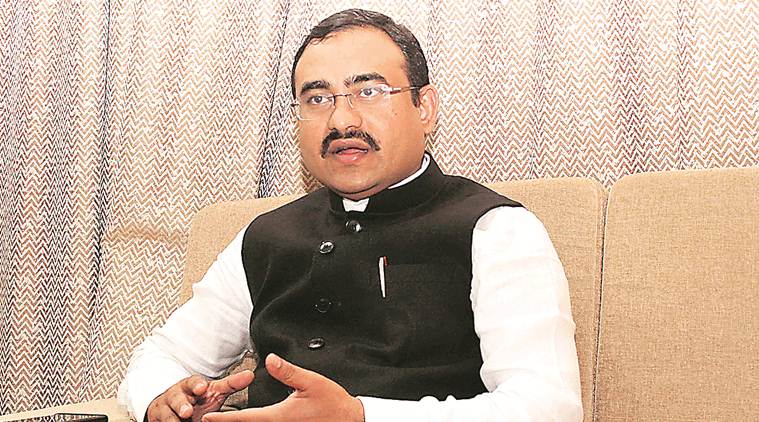- India
- International
Earthquake-resistant homes the only way forward along with people being prepared: Palghar collector
Dahanu in Palghar has been experiencing earthquake swarms for over four months now. Affected residents are sleeping outside in tents with the administration joining hands with the NDRF and local NGOs for providing people with makeshift homes. Prashant Narnaware , district collector of Palghar, talks to The Indian Express about preparedness and long-term solutions in anticipation of a bigger earthquake.
 Prashant Narnaware
Prashant Narnaware
What are the experts’ report findings on what is causing the earthquakes in Dahanu?
For the past four and a half months, we have been experiencing earthquake swarms that range from 2.8 to 3.6 on the Richter scale. The NGRI (National Geophysical Research Institute) and IIT Bombay have found a seismographic fault line in the area between the tectonic plates, that were dormant till now but have become active recently. Whenever there is a release of energy, there is an earthquake. It is believed that as long as the energy is being released gradually and finds the outlet for release, there won’t be a big earthquake but the swarms might continue.
Explained | Why is Palghar being repeatedly jolted by earthquakes?
The earthquake swarm has been on for over four months, yet you began relief work only after a four-year-old girl died on February 1. Why the delay?
After the first tremor, our disaster management team surveyed the entire area. We also started awareness generation programmes. When the swarms continued, we contacted NGRI, IIT, and other specialised bodies. Within 10 days of the first tremors, we installed the first seismograph in the area. Now, we have five of different research institutes. At the time, there was no permanent damage to houses. After the most severe tremor on February 1, we reached out to them. Before that, the ambulance teams and police were already monitoring the situation and making rounds. We then decided to call the NDRF (National Disaster Response Force). Earthquakes can’t be predicted, so we decided to take pre-emptive action. People were unwilling to sleep inside their houses, so we decided to give them tents. We have installed temporary shanties and tents in ashram schools. Wherever there are demands, we help them with tarpaulin sheets.
How long do you think people can go on living in tents? Is there a long-term solution?
The best we can do in situations such as these is to prepare ourselves. These are temporary living conditions. The long-term solution is to make houses and buildings resistant to earthquakes. We are focusing on retrofitting the existing houses. Even the new houses that will be built under the PM Awas Yojana (Pradhan Mantri Awas Yojana) will be specially constructed to withstand earthquakes. For private houses, while we can’t fund the retrofitting of all the houses, we have identified 1,300 severely damaged houses and ‘at risk’ houses. We are talking to the public works department and others to bring together local contractors and masons and teach them about earthquake-resistant construction. We have been quick in giving out the compensation, so that people use the money and refurbish their houses at the earliest. The compensation is never equal to the damage, but it helps. Earthquake-resistant houses are the only way forward, along with people being prepared for it.
How much money has been given out as compensation and in other relief measures?
We have had to spend only on tarpaulin sheets which have cost around Rs 20 to 25 lakh. The compensation comes from the government. We have a free hand by to use the money available as generally we can spend only 10 per cent of the money.
Are we ready for a disaster of a large scale? Is there a plan of action if something happens?
We are ready to deal with it. We have set up an emergency system, we have given them toll-free numbers. These numbers are displayed across villages on boards that we have put up near gram panchayat offices. We have conducted drills in Dhundalwadi, about what is to be done in case of a disaster. Our medical teams, revenue teams, gram panchayat level teams are all ready. At the same time, we have taken the disaster mitigation plans of all big installations like Tarapur atomic plant, Reliance thermal power plant, Reliance gas pipeline and other private organisations. We have also looked at our dams. We have sent them notices, got their compliance and received their reports. At the same time, we have prepared local teams, because they are the first to be affected by disaster.

How much land has been acquired for bullet train in Palghar? What are your biggest challenges in negotiating with the people?
Total land acquisition till now is almost a hectare in Vasai and Palghar. There are several challenges, but we are trying to overcome them as we are giving people good compensation and remuneration. We hope, in the days to come, the attitude towards the bullet train will change. In urban areas, we have to consider how much FSI (floor space index) is to be given, how much land we need to give, whether we are giving money or ready-made houses. Several houses are encroachments on government land. So, the residents are unsure if they will get anything. But we have responded positively to all of these questions. Whether it’s legal or not, people are losing their houses and we need to be mindful of that. So, compensation will be there for everyone, but the scale might vary. The CRZ (coastal regulation zone) issue is also something we have had to explain to people. We are working with legal teams to come up with mutually beneficial solutions so that farmers don’t suffer losses on giving us the land. In Dahanu and Talasari, the issues that we face are completely different as these are tribal belts with forest land. There is encroachment of tribals on government land, on forest land which is yet to be regularised and even private land which is leading to a lot of issues as to who should get the compensation. We have given all of these questions regarding livelihood and compensation to the NHSRCL (National High Speed Rail Corporation), and have asked them to respond. We have received some responses which we are relaying back to concerned people.
Last monsoon, Vasai-Virar saw massive flooding. What steps have been taken to prevent the flood from occurring again?
We have had meetings and consultations with several organisations, stakeholders and our Vasai Virar City Municipal Corporation. We also spoke to builders and residents. The areas that were flooded are low-lying areas and some are even illegal. But those are houses and people can’t be thrown on to the streets. So, we are focusing on installing machinery such as storm water drains and pumping equipment are being made available. I expect that before the monsoon arrives, we will be ready. We have little time on our hands, but it is just enough for us to drive into action. With proper cleaning of drains and natural exits for the water, we can salvage the situation. We have also contacted the BMC; they have high energy pumps to keep pumping water out of the city. We don’t have their resources, but we can learn and adapt from them.
Apr 24: Latest News
- 01
- 02
- 03
- 04
- 05







































